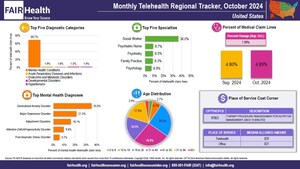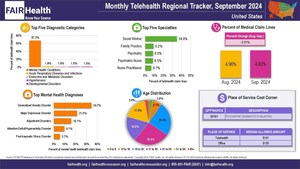Fifth Annual FAIR Health Report Captures Impact of COVID-19 Pandemic on Healthcare System
Telehealth Utilization Grew Nationally 7,060 Percent from 2019 to 2020
All Other Venues of Care Studied, such as Emergency Rooms and Urgent Care, Showed Decreases in Utilization
NEW YORK, March 31, 2022 /PRNewswire/ -- Telehealth utilization grew nationally 7,060 percent from 2019 to 2020, an increase driven by the COVID-19 pandemic and the limits imposed on certain in-office services, coupled with the greater risk of infection from in-person encounters.1 This is among the findings in a new FAIR Health white paper containing the fifth annual edition of FH® Healthcare Indicators and FH® Medical Price Index. Like the previous editions, this year's edition of FH Healthcare Indicators and FH Medical Price Index is intended to provide clarity to all healthcare stakeholders in a rapidly changing healthcare environment.
FH Healthcare Indicators
FH Healthcare Indicators reveal trends and patterns in the places where patients receive healthcare. Focusing on alternative places of service—retail clinics, urgent care centers, telehealth and ambulatory surgery centers (ASCs)—as well as emergency rooms (ERs), FH Healthcare Indicators evaluate changes in utilization, geographic and demographic factors, diagnoses, procedures and costs.
Among the other key findings:
- Telehealth utilization increased nationally 41,919 percent from 2015 to 2020, a more than 40-fold increase over the growth of 1,019 percent from 2014 to 2019 reported in last year's edition.
- In all other places of service studied for changes in utilization, utilization decreased from 2019 to 2020, probably due to the impact of COVID-19. Utilization fell 38 percent in ASCs, 30 percent in ERs, 16 percent in urgent care centers and 4 percent in retail clinics.
- In 2020 as in previous years, more claim lines were submitted for females than males in most age groups in the places of service in which FAIR Health studied gender-related patterns—retail clinics, urgent care centers, telehealth, ASCs and ERs.
- However, in some places of service, such as retail clinics, urgent care centers, ASCs and ERs, the gap between males and females narrowed. For example, in ERs, in the age group 61-70, the male and female shares were approximately equal (50 percent) in 2020, a change from 2019, when the female share had been 52 percent and the male share 48 percent. This trend bears monitoring in the future.
- In 2020, exposure to communicable diseases joined the list of the most common diagnostic categories in retail clinics, urgent care centers and telehealth. This category largely was associated with testing and/or treatment for COVID-19 when a patient was exposed to the condition.
- Across offices, urgent care centers and retail clinics in 2019, urgent care centers had the highest median charge amount for CPT®2 99203 (30-44-minute new patient office visit), but in 2020 the median charge for an office ($226) was slightly higher than that for an urgent care center ($221).
FH Medical Price Index
FH Medical Price Index reports shifts in costs and facilitates useful comparisons among medical prices in six procedure categories from May 2012 to November 2021:
- Professional evaluation and management (E&M3; excluding E&Ms performed in a hospital setting);
- Hospital E&M (excluding E&Ms performed in a professional setting, such as typical office visits);
- Medicine (excluding E&Ms);
- Surgery (procedures for which the physician would bill);
- Pathology and laboratory (technical and professional components, e.g., both equipment and professional services); and
- Radiology (technical and professional components).
The reports reflect professional fees and related costs; they do not reflect facility fees.
For the period November 2020 to November 2021:
- Of the six procedure categories, hospital E&Ms had the greatest percent increase in charge amount index, seven percent, and in allowed amount index, five percent.
- Radiology and medicine each had the smallest percent increase in charge amount index, two percent.
- Radiology had the smallest percent increase in allowed amount index, one percent.
FAIR Health President Robin Gelburd stated: "This year's edition of FH Healthcare Indicators and FH Medical Price Index opens a window on the impact of the COVID-19 pandemic on the nation's healthcare system. We hope that this new edition, like those in previous years, continues to inform decision making throughout the healthcare sector by payors, providers, government officials, policy makers, academic researchers and others."
For the new white paper, FH® Healthcare Indicators and FH® Medical Price Index 2022: An Annual View of Place of Service Trends and Medical Pricing, click here.
Follow us on Twitter @FAIRHealth
About FAIR Health
FAIR Health is a national, independent nonprofit organization that qualifies as a public charity under section 501(c)(3) of the federal tax code. It is dedicated to bringing transparency to healthcare costs and health insurance information through data products, consumer resources and health systems research support. FAIR Health possesses the nation's largest collection of private healthcare claims data, which includes over 36 billion claim records and is growing at a rate of over 2 billion claim records a year. FAIR Health licenses its privately billed data and data products—including benchmark modules, data visualizations, custom analytics and market indices—to commercial insurers and self-insurers, employers, providers, hospitals and healthcare systems, government agencies, researchers and others. Certified by the Centers for Medicare & Medicaid Services (CMS) as a national Qualified Entity, FAIR Health also receives data representing the experience of all individuals enrolled in traditional Medicare Parts A, B and D; FAIR Health includes among the private claims data in its database, data on Medicare Advantage enrollees. FAIR Health can produce insightful analytic reports and data products based on combined Medicare and commercial claims data for government, providers, payors and other authorized users. FAIR Health's systems for processing and storing protected health information have earned HITRUST CSF certification and achieved AICPA SOC 2 compliance by meeting the rigorous data security requirements of these standards. As a testament to the reliability and objectivity of FAIR Health data, the data have been incorporated in statutes and regulations around the country and designated as the official, neutral data source for a variety of state health programs, including workers' compensation and personal injury protection (PIP) programs. FAIR Health data serve as an official reference point in support of certain state balance billing laws that protect consumers against bills for surprise out-of-network and emergency services. FAIR Health also uses its database to power a free consumer website available in English and Spanish, which enables consumers to estimate and plan for their healthcare expenditures and offers a rich educational platform on health insurance. An English/Spanish mobile app offers the same educational platform in a concise format and links to the cost estimation tools. The website has been honored by the White House Summit on Smart Disclosure, the Agency for Healthcare Research and Quality (AHRQ), URAC, the eHealthcare Leadership Awards, appPicker, Employee Benefit News and Kiplinger's Personal Finance. FAIR Health also is named a top resource for patients in Dr. Marty Makary's book The Price We Pay: What Broke American Health Care—and How to Fix It and Dr. Elisabeth Rosenthal's book An American Sickness: How Healthcare Became Big Business and How You Can Take It Back. For more information on FAIR Health, visit fairhealth.org.
Contact:
Rachel Kent
Senior Director of Marketing
FAIR Health
646-396-0795
[email protected]
1 Utilization in this study is a relative, normalized measure, not an absolute one. See Methodology section of the white paper.
2 CPT © 2021 American Medical Association (AMA). All rights reserved.
3 An E&M is a patient-provider visit, such as for an examination, to diagnose illness or to determine or manage treatment. Professional E&Ms are typically done in a professional setting, such as a doctor's office, while hospital E&Ms are done in a hospital setting.
SOURCE FAIR Health

WANT YOUR COMPANY'S NEWS FEATURED ON PRNEWSWIRE.COM?
Newsrooms &
Influencers
Digital Media
Outlets
Journalists
Opted In







Share this article